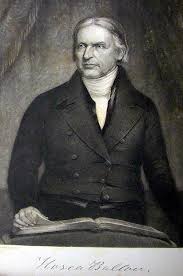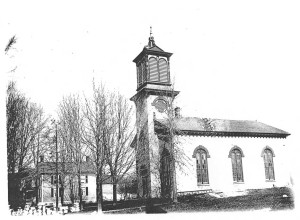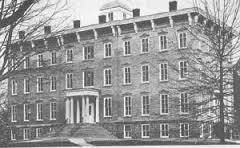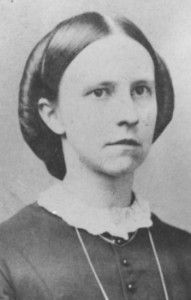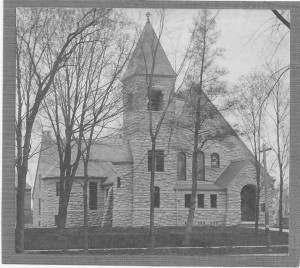History
A Short History of the "Universalist Church on the Green"
In the late 1700s and early 1800s, circuit riding preachers including Hosea Ballou streamed into northern and upstate New York with a new message. It was a message of a God whose love for humankind was universal, in contrast to the mainstream Calvinist theologies of hellfire and damnation.
The messages of salvation for all brought by these preachers found fertile ground among these rural folk. By the 1820s small groups of these new Universalists were gathering to explore and then follow this new and comforting message.
In 1824, a Universalist Church was gathered in Potsdam NY and formally organized in October 7, 1825. At the same time a similar group was meeting in Canton, organized on November 17, 1825. Both groups were inspired in this undertaking
by the circuit riders whose purpose was to “bring the still new teachings of universal salvation to areas dominated by partialist error.” Both groups met initially in local schoolhouses, but both soon built church structures of their own. The Canton Universalists joined with a group of Baptists to build a Union Church in 1827-29, fondly remembered as “The Brick Church.” The dedicatory sermon was preached by Jonathan Wallace of Potsdam’s First Universalist Church. From the beginning the Potsdam and Canton Universalist congregations were partners in this grand undertaking, and even appeared to have shared a minister in the early days.
As can be imagined, the Canton Universalists’ partnership with the Baptists was fraught from its inception. In 1837, the Universalists finally bought out the Baptist’s share, and from that time to the present, a Universalist Church has stood on the same plot of ground on the Village Park in Canton.
Theologically the Canton Universalists of that time were relatively conservative by current standards. They held to the tenets of the Winchester Profession of 1803, but where they differed from other Protestants was a fierce opposition to the Calvinist doctrines of “election” and “faith without works.” They often referred to “partialist error,” the doctrine that only some were worthy of salvation.
From the early days the charter members of The First Universalist Society in the Town of Canton were among the movers and shakers in the region and in the denomination. They were instrumental in forming the St. Lawrence Association of Universalists in 1828 to create a formal bond to hold churches together for mutual aid and common concern including filling empty pulpits. By 1870, New York had more Universalists than any other state, in significant part because of these hardy rural folks in St Lawrence County and in Canton.
A significant event in early Universalist history in America arose in response to a need for schools that would open our children’s minds (and keep them open!), and which would not be promoting the dreaded “partialist error.” An educated church leadership was also identified as a need. By mid century, the New York Universalists were convinced that they needed their own school to train ministers for their churches. In 1852, the New York Convention of Universalists appointed the 16-member Educational Society to raise money necessary to establish a Universalist Theological School. Four of those men had strong ties to the Canton Church: Rev. William Balch, Rev. John Temple Goodrich, Rev. Seth Williston Remington, and Mr. Martin Thatcher. Due to their energetic support and skillful fundraising, Canton was ultimately selected as the site for the new school, with land on the hill above the village dedicated for that purpose.
The St. Lawrence Theological School opened its doors in 1856 in what is now called Richardson Hall with Rev. Ebenezer Fisher as President. Not everyone was happy about this outcome; the local Presbyterian minister was said to have referred to the school as “that dung heap on the hill.” But the school survived and prepared many Universalist ministers for over a century until it closed in 1965. Throughout those years close ties continued between the Canton congregation and the Theological School. Commencements were held in our church. Professors at the School were frequent pulpit speakers in Canton and well as in the many smaller Universalist societies in the county. (Note: As many as 34 such groups have some record of activity throughout the 1800s and into the early 1900s.) As had been the plan all along, a preparatory school opened alongside the theological school in 1860 under the leadership of John Stebbins Lee, and it soon became the St. Lawrence University that we know today, giving parents a post-secondary school they could feel comfortable would not infect their sons and daughters with partialist error.
Another important event in the history of this region occurred in 1861 when Olympia Brown was admitted to the Theological School to prepare for the Universalist ministry. Rev. Fisher attempted to dissuade her from enrolling, but she would not be deterred. During her days at the school, she preached on occasion in our St. Lawrence County churches. She completed her course of study in 1863, and over Rev. Fisher’s continued objections, the St. Lawrence Association of Universalists voted to approve her ordination, making her the first woman to be ordained with full ministerial standing by a denominational body. She went on to serve several churches and was also active in women’s suffrage movement throughout her life.
The remainder of the century was a lively time in Canton and the county. Churches were popping up everywhere. Students from the theological school frequently supplied country pulpits. The Canton congregation was also moving forward. In the 1860s, the Ladies Circle was reconstituted to help raise funds for the church.

Tracker organ, built around 1866 by George N. Andrews
This resulted in raising $1600 for the purchase of our Andrews tracker organ, installed in 1869 after a remodel of the church building to accommodate the instrument, still in use today. They also bought the Silas Wright house next door for use as a parsonage. (This building is now the home of the St. Lawrence Historical Society.) When all that was handled, the ladies set an even loftier goal: to build a new marble church building to afford the space needed by this active and growing congregation.
The 1890s under the ministry of James Payson saw those dreams fulfilled. To do this, the congregation needed to raise $20,000; the Ladies Circle, Dr. Henry Priest, and Dr. Payson were valiant in the attempt. The funds were raised, the cornerstone laid, the church built, and our Andrews organ reinstalled in its new home. The dedication service for the new church was held on April 15, 1897 on the same site we had occupied since 1827.
The 1900s saw the Canton church settling into the business of “doing church.” Dr. Payson served us for a total of 13 years, with a 13-year break to found the agricultural school at in Canton (now SUNY Canton). Dr. Isaac Atwood served us from 1912-1917 after serving as General Superintendent of the Universalist General Convention, moving on from our pulpit to teach at the Theological School. During this time, the Ladies Circle continued its ambitious work, and the Sunday School and Young Peoples Christian Union (YPCU) flourished with infusion of energetic volunteer teachers from SLU. The Mission Circle raised money for projects in foreign countries and studied issues related to challenges facing minority groups.
Music was (and still is) incredibly important in this church.
Miss Carrie Storrs became our organist and choir director in 1876 and served the church until 1924. The stained glass window near the organ, shown at left, was erected in honor of her long years of service. Other organists of long service include Tom Finch (1966-1986) and Nelly Case who will retire this year after 28 years of service. The Crane School of Music in Potsdam brought many talented musicians to our area, and they frequently performed in services in at the Canton church, as they still do today.
In the first two decades of the 1900s, the Universalist groups throughout the region began to wane in membership and activity. There has been much speculation on the cause of the decline, including the advent of the automobile, the theological shift by other churches toward a more loving God, and a general population shift toward urban areas and away from rural communities. Ironically, the Canton Church seemed to benefit somewhat from their demise, with reports continuing of strong attendance at church services and in the Sunday School. It was also during this time that our numerous memorial stained glass windows were commissioned and installed, commemorating past members and leaders.
From 1923-1958, we were served by a number of ministers, each of whom brought unique styles and gifts. Most of them were graduates of the Theological School at SLU and knew us well. Rev. Edna Bruner served our church as our first female minister in 1945-1950, as well being the first woman to serve any church in Canton. Members of our church were instrumental in the establishment of Unirondack as a church camp in 1951. This period also saw reorganization of various groups in the church (e.g., youth, women, Sunday School) as we were drifting ever closer to the merger decision.
In 1958, the congregation called Rev. Max Alden Coots to be our minister. As it turned out, Max was to bring us through a number of hard times, and we changed our name (although not, it turns out, legally as we are still incorporated as the First Universalist Church of Canton today!) There were very mixed feelings about the merger, and for many years our connection to the larger denomination was fragile. In 1965 the Theological School closed, changing our relationship to St. Lawrence University forever. During the 1960s and 70s, there was increasing emphasis on social justice issues. Our church was a source of information on draft issues during the Vietnam war. In 1974, the Canton UU Church joined with 6 other Canton churches to found the Church and Community Program. This successful partnership continues its work today, assisting area families in dealing with food, shelter and heat insecurities. Max preached his last sermon in June 1992, retiring after 35 years of service, our longest pastorate to date.
In 1993, we called a new minister… or more precisely, a husband/wife co-minister team, Rev. Anne Marsh and Rev. Wade Wheelock, who served us until their retirement in 2009. Under their ministry, we became more consistently Unitarian Universalist, with a decidedly rural North Country sensibility. We renovated and enlarged (to our back lot line!) our historic marble church just as our forebears had done, with a very successful capital campaign. After Rev Marsh and Wheelock’s retirement, Rev. Myron Andes served as our interim for one year and Rev. David Blanchard was selected as our settled minister in 2011. We grew stronger as a congregation under Rev. Blanchard’s guidance and accomplished another successful capital campaign that helped us to renovate our roof and interiors. Rev. Blanchard chose to resign for personal reasons in 2013. The congregation then called in Rev. Joel Miller as our interim minister. Rev. Miller has led us in a vision of shared ministry and helped the congregation introspect and reflect on several key factors.
Members of our church pursue a variety of ministries- social justice, religious education, worship, music, welcoming, and caring. We became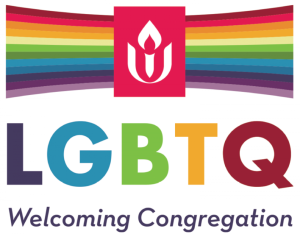 a Welcoming Congregation in 1997 and helped establish a local PFLAG group. Recently we achieved denominational recognition as a Green Sanctuary.
a Welcoming Congregation in 1997 and helped establish a local PFLAG group. Recently we achieved denominational recognition as a Green Sanctuary.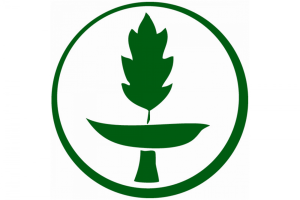
As our children say every Sunday, we work hard to be “the church of the open mind, the loving heart, and the helping hands.” This is a heritage we are proud of and for which we are grateful to those who came before us. We are now seeking a new minister to join with us, one who will respect our past and trust the “dawning future.”
Want to know more about our history?  Two of our congregation members taught a course this past October for a local lifelong-learning program called SOAR. They've shared the content for that course, which was entitled "Loving the Hell Out of the World: Universalists and Their Influence in Northern New York." You may view all three parts, each opening in a new window, in a pdf-format:
Two of our congregation members taught a course this past October for a local lifelong-learning program called SOAR. They've shared the content for that course, which was entitled "Loving the Hell Out of the World: Universalists and Their Influence in Northern New York." You may view all three parts, each opening in a new window, in a pdf-format:
UU SOAR-Presentation1 UU-SOAR-Presentation2 UU-SOAR-Presentation3

